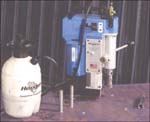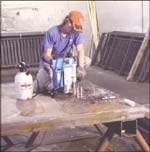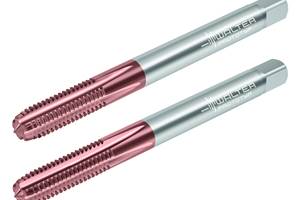Portable Drill And Tooling Combination Solves Fabricator's Dilemma
Jackal Fabrication (Whitehall, Michigan) is accustomed to meeting time schedules, bidding competitively and striving to achieve quality workmanship. Its founder and president, Jack Budde, along with Bryan Hughes, partner and CFO, and Vice President Bob McCann have extensive experience in steel fabrications for structural and ornamental projects.
Share





Hwacheon Machinery America, Inc.
Featured Content
View More


Jackal Fabrication (Whitehall, Michigan) is accustomed to meeting time schedules, bidding competitively and striving to achieve quality workmanship. Its founder and president, Jack Budde, along with Bryan Hughes, partner and CFO, and Vice President Bob McCann have extensive experience in steel fabrications for structural and ornamental projects. The company has put up the structural components of a college student center and has supplied the stairways and railing for municipal water treatment facilities. It was also involved in the railing work—more than a half mile of black railing and perforated stainless steel panels—on a pedestrian bridge leading to Chicago's newly renovated Soldier Field.
One of the company's recent projects includes a new food and beverage service pavilion, measuring 28 feet by 48 feet, fabricated and installed at Chicago's Grant Park. This job called for drilling 60 holes, and it almost came to a halt at one point.
"The park authority came up with a plan to use the area of the outdoor skating rink during warm spring, summer and fall months," explains Mr. McCann. "The plans included a small band shell and a semi-permanent food pavilion structure, which would remain throughout the warm periods and would then be removed during the ice skating season." The challenge was to securely anchor the pavilion without damaging the rink's coolant lines, which are imbedded in the concrete base.
"The plan was to construct a foundation using 14 steel plates placed on top of the concrete rink base, to which the structure's columns would be bolted," he continues.
The steel plates were made from 4-inch thick plate, and eight plates were 5 feet 6 inches, with six 4-foot plates. The 14 columns of the structure were to be attached to the plates, one column per plate. To secure the columns with the bolts, the company needed to drill four 1 1/16-inch diameter holes through each plate and one hole each in four plates, for a total of 60 holes.
"The plates weighed about 4,900 pounds and 2,600 pounds respectively, making it difficult to move to the machines; we didn't have equipment large enough to handle the job," says Mr. Budde. "There was the option to ship the job out, but that would've been costly. Time was also an issue because the entire project had to be completed in 4 weeks."
Jackal Fabrication found a way to solve its dilemma by working with Hougen Manufacturing (Flint, Michigan) and one of its distributors, Lake Welding Supply (Muskegon, Michigan). Using Hougen's two-speed HMD505 portable magnetic drill and its Rotabroach annular cutters, the company incorporated a two-tool approach. With this approach, a standard size cutter was used for the initial operation, and then an extended reach and depth-of-cut tool completed the hole through the 4-inch material. According to the manufacturer, these extended reach cutters are typically suited for applications in which drilling two aligned holes in the flange areas of Ibeams, square tubing or a channel is required.
The HMD505 features a customized quill- feed arbor design that is designed to provide a fast and smooth feed into and throughout the cut, especially in deep hole drilling. This configuration virtually eliminates the need for gib and slide adjustments.
The drill's holemaking capacity is 2 3/8 inches in diameter, with a 3-inch depth of cut. This was problematic because the typical depth of cut of this model and its corresponding tooling was not sufficient to drill through the pavilion's base plates.
Lake Welding Supply's Tom Krause and Hougen representative Bill Otero suggested the dual cutter idea as an economical solution. The application was then completed in a two-step operation. The first step involved drilling the 11/16-inch diameter holes to a 2-inch depth using one of Hougen's standard-length cutters. In the second step, the 4-inch depth cutter was installed in the drill's arbor. The mounted cutter was then fed into the hole simultaneously as the drill was lowered into position on the plate and the holes were completed through the material.
The drilling operation took about 1 hour per plate, which included about 40 minutes of actual drilling time to complete all four holes, tool change-over and positioning the drill.
"This degree of productivity would have been difficult to attain even with the largest of machine tools," Mr. McCann notes. "Considering the time frame, we had no alternative."
The drill's electrical ratings include 1,680 W, 14 amps and 50/60 Hz, combined with two-speed gearing (250 and 450 no-load rpm).
To augment the drilling power of the HMD505, the Rotabroach annular cutters cut round holes that are virtually free of burs, the manufacturer says. The cutters are available in sizes from 7/16 inch to 2 3/8 inches and in 12-mm to 51-mm diameters, with the option of 1-inch, 2-inch or 3-inch depths of cut. The extended reach cutters are available in 4-inch depth of cut, with sizes ranging from 13/16 inch to 1 3/16 inches in diameter. A 6-inch depth of cut version with 13/16-inch to 1 1/16-inch diameters is also offered.
According to Mr. McCann, the pressurize coolant option played a significant role in the application. While keeping the tools lubricated, it reduced heat buildup through the depth of the cut and also aided in chip evacuation deep in the cut.
"The drilling operations were completed with little wear to the tools," reports Mr. McCann. "Our installation crews travel to job sites with at least one portable drill for field work, and now we won't be without one in the shop."
Related Content
Kennametal's Expanded Tooling Portfolio Improves Performance
The company has launch eight new products that expand on and support existing platforms across multiple applications.
Read MoreCustom PCD Tools Extend Shop’s Tool Life Upward of Ten Times
Adopting PCD tooling has extended FT Precision’s tool life from days to months — and the test drill is still going strong.
Read MoreKennametal Expands Modular Drilling Platform
The KenTip FS GTP insert allows for multiple machining applications across materials including steel, stainless steel and cast iron.
Read MoreWalter Offers New Solid-Carbide Taps for Blind-Hole Machining
Walter’s TC388 Supreme and TC389 Supreme feature patent-pending cutting geometries that fully shear off the root of the chip when reversing, thus minimizing torque peaks.
Read MoreRead Next
Registration Now Open for the Precision Machining Technology Show (PMTS) 2025
The precision machining industry’s premier event returns to Cleveland, OH, April 1-3.
Read More5 Rules of Thumb for Buying CNC Machine Tools
Use these tips to carefully plan your machine tool purchases and to avoid regretting your decision later.
Read MoreBuilding Out a Foundation for Student Machinists
Autodesk and Haas have teamed up to produce an introductory course for students that covers the basics of CAD, CAM and CNC while providing them with a portfolio part.
Read More



































.jpg;maxWidth=300;quality=90)















